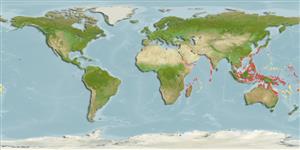>
Gobiiformes (Gobies) >
Gobiidae (Gobies) > Gobionellinae
Etymology: Mugilogobius: Latin, mugil, -ilis = grey mullet + Latin, gobius = gidgeon (Ref. 45335).
Eponymy: Dr Hugo Philip Ralph Merton (1879–1940) was a German zoologist and explorer. [...] (Ref. 128868), visit book page.
More on author: Weber.
Environment: milieu / climate zone / djupintervall / distribution range
Ekologi
marina; sötvatten; brackvatten bentopelagisk; amfidrom (Ref. 46888); djupintervall 0 - 5 m (Ref. 86942). Tropical (Ref. 13275)
Indo Pacific: from South Africa and Seychelles up to Japan, Pakistan, to the Indo-Malaysian archipelago, Papua-New Guinea, New Caledonia, Vanuatu, Australia and Santa Cruz Islands (Ref. 97791).
Size / Vikt / Age
Könsmognad: Lm ? range ? - ? cm
Max length : 6.0 cm SL hane/ej könsbestämd; (Ref. 57749)
Short description
Bestämningsnycklar | Morfologi | Morfometri
Taggstrålar i ryggfenan (totalt) : 7 - 8; Mjukstrålar i ryggfenan (totalt) : 6 - 8; Taggstrålar i analfenan: 1; Mjukstrålar i analfenan: 6 - 8; Ryggkotor: 25 - 27. Diagnosis: A moderate to large Mugilogobius with second dorsal and anal fin with 1 spine and 6-8 rays; pectoral fin rays 14-17; longitudinal scales 26-37; 12-16 circumpeduncular scales; predorsal scales 9-19, mostly small, central anteriormost scale immediately behind eyes always largest, anteriormost one to four scales larger than those posterior to them; scales on body mostly ctenoid; third spine of first dorsal fin most often longest; body brownish with 7-11 darker narrow diagonal bars, chevrons or X-shaped markings along sides, interspaces between chevrons or bars pale, forming chequered or banded pattern, two to three dark spots or short diagonal bars on caudal base (Ref. 43716).
Body shape (shape guide): fusiform / normal.
Facultative air-breathing in the genus (Ref. 126274); Mainly recorded from mangroves and estuaries, but also found in coastal freshwater streams (Ref. 43716).
Life cycle and mating behavior
Könsmognad | Reproduktion | Lek | Ägg | Fecundity | Larver
Larson, H.K. and E.O. Murdy, 2001. Eleotrididae. Sleepers (gudgeons). p. 3574-3577. In K.E. Carpenter and V. Niem (eds.) FAO species identification guide for fishery purposes. The living marine resources of the Western Central Pacific. Vol. 6. Bony fishes part 4 (Labridae to Latimeriidae), estuarine crocodiles. FAO, Rome. (Ref. 42913)
IUCN Red List Status (Ref. 130435: Version 2024-2)
Threat to humans
Harmless
Human uses
Verktyg
Special reports
Download XML
Internet-källor
Estimates based on models
Preferred temperature (Ref.
123201): 25 - 29.3, mean 28.5 °C (based on 2341 cells).
Phylogenetic diversity index (Ref.
82804): PD
50 = 0.5000 [Uniqueness, from 0.5 = low to 2.0 = high].
Bayesian length-weight: a=0.00977 (0.00444 - 0.02153), b=3.04 (2.85 - 3.23), in cm total length, based on LWR estimates for this (Sub)family-body shape (Ref.
93245).
Trofisk nivå (Ref.
69278): 3.5 ±0.4 se; based on size and trophs of closest relatives
Resiliens (Ref.
120179): Hög, lägsta populationsfördubblingstid mindre än 15 månader (Preliminary K or Fecundity.).
Fishing Vulnerability (Ref.
59153): Low vulnerability (10 of 100).
🛈
